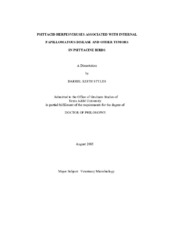| dc.description.abstract | Internal papillomatous disease (IPD) is characterized by mucosal papillomas
occurring primarily in the oral cavity and cloaca of Neotropical parrots. These lesions
can cause considerable morbidity, and in some cases result in mortality. Efforts to
demonstrate papillomavirus DNA or proteins in the lesions have been largely
unsuccessful. However, increasing evidence suggests that mucosal papillomas may
contain psittacid herpesviruses (PsHVs). In this study, PsHV 1 genotype 1, 2, and 3
DNA was found in 100% of mucosal papillomas from 30 Neotropical parrots by PCR
using PsHV specific primers. However, Psittacus erithacus papillomavirus and finch
papillomavirus DNA were not detected. Additionally, a novel PsHV sequence related
to, but phylogenetically distinct from PsHV 1, was identified in 4 African grey parrots
(Psittacus erithacus), two of which exhibited papillomas. These findings suggest that
mucosal papillomas may develop in parrots latently infected with PsHV. Tumors of the
bile and pancreatic ducts have also been observed in parrots with IPD. Other mucosal
tumors including carcinomas of the proventriculus and ventriculus may be coincident with bile duct tumors, but cloacal carcinomas usually develop as solitary lesions. To test
whether PsHV was associated with these tumors, the fresh tissues from 11 parrots and
the formalin-fixed paraffin-embedded (FFPE) tissues of 5 parrots exhibiting mucosal
tumors were examined by PCR. All tumors were found to contain PsHV 1 genotype 3
DNA except one bird with a cloacal carcinoma that contained genotype 4.
Histologically normal tissues available from six parrots did not contain PsHV DNA.
Experiments were performed using the FFPE tissues of 5 parrots with IPD related
tumors known to contain PsHV by PCR, to show that the virus was in significantly
higher concentration in the neoplastic tissue compared to adjacent histologically normal
tissue. Neoplastic and adjacent unaffected cells were dissected from the tissues using
laser capture microdissection and the DNA was examined by PCR. In situ hybridization
using PsHV specific probes and direct in situ PCR were also performed on the tissues.
A strong association was shown between infection by PsHV 1 genotype 3 and birds
manifesting IPD related tumors and other neoplasms of the digestive tract. | en |


